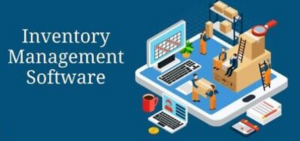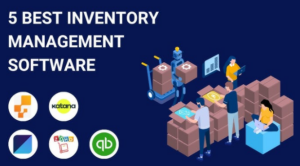Inventory Management Software for Small Businesses –
Discover top inventory management software tailored for small businesses. Compare features, prices, and benefits to streamline your operations and boost efficiency!
The Best Inventory Management Software for Small Businesses in 2024

Managing inventory efficiently is critical for any small business. Whether you’re tracking products in a retail store, overseeing a warehouse, or handling online sales, having the right tools is essential for staying competitive. In this guide, we’ll explore the best inventory management software designed specifically for small businesses. We’ll discuss their key features, benefits, real-world examples, pricing, and where to purchase.
Let’s dive in!
Why Do Small Businesses Need Inventory Management Software?
Small businesses need inventory management software to streamline their operations, reduce errors, and save time. Managing inventory manually can become overwhelming as the business grows, leading to inefficiencies that can hurt the bottom line. Here’s a breakdown of why inventory management software is essential:
1. Automation for Increased Efficiency
Inventory management software automates repetitive tasks such as tracking stock levels, updating reorder points, and generating reports. This reduces the need for manual work and allows business owners and employees to focus on more critical aspects of the business, like customer service and sales.
2. Real-Time Insights and Tracking
With inventory management software, small businesses can access real-time data on their inventory. This includes stock levels, product movements, and sales trends. Real-time tracking helps businesses make data-driven decisions, ensuring they always have the right products in stock without overordering or underordering.
3. Minimization of Errors
Manual inventory tracking is prone to human error, which can lead to stock discrepancies, missed orders, and financial losses. By using software, small businesses can minimize mistakes related to data entry, pricing, and inventory counts, leading to smoother operations.
4. Cost Savings and Profitability
Efficient inventory management helps prevent overstocking or understocking, both of which can be costly. Overstocking leads to unsold goods that take up storage space and may need to be discounted, while understocking can result in missed sales opportunities. Inventory management software ensures optimal stock levels, reducing excess costs and improving profitability.
5. Improved Customer Satisfaction
Nothing frustrates customers more than finding out that a product is out of stock after they’ve placed an order. Inventory management software helps businesses maintain adequate stock levels, so they’re always ready to fulfill customer orders, which leads to improved customer satisfaction and loyalty.
6. Scalability for Growing Businesses
As small businesses grow, their inventory management needs become more complex. Inventory management software can scale with the business, making it easy to add more products, sales channels, and locations without needing to overhaul the system.
7. Centralized Management
Many inventory management solutions integrate with other systems like point-of-sale (POS) platforms, eCommerce websites, and accounting software. This creates a centralized hub where small businesses can manage their inventory, sales, and finances from one place.
8. Better Forecasting and Planning
Using historical data and sales trends, inventory management software can help businesses forecast demand and plan for future sales cycles. This prevents last-minute stockouts and ensures businesses are prepared for seasonal spikes in demand.
Benefits of Using Inventory Management Software for Small Businesses
- Increased Efficiency
Inventory management software automates repetitive tasks like data entry, stock tracking, and reporting, allowing business owners to focus on growth rather than manual processes. - Minimized Errors
Human errors in inventory management can lead to significant financial losses. By using software, small businesses can reduce errors related to data entry, pricing, and order fulfillment. - Enhanced Scalability
As your business grows, inventory management software can scale with you. You won’t have to switch systems as you expand, ensuring a seamless transition during periods of growth. - Centralized Management
Many software solutions integrate with point-of-sale (POS) systems, eCommerce platforms, and warehouses, providing a centralized platform to manage all inventory operations.
Top 5 Inventory Management Software for Small Businesses

Here are five top-rated inventory management software tailored for small businesses. Each product offers unique features and benefits, ensuring you’ll find the perfect match for your needs.
1. Zoho Inventory
Website: Zoho Inventory
Zoho Inventory is a robust solution offering seamless integration with major eCommerce platforms like Amazon and eBay. With its multi-channel sales support and real-time tracking features, Zoho Inventory is perfect for small businesses looking for flexibility.
Features:
- Real-time inventory tracking
- Multi-channel sales integration
- Automation for reorder levels
- Shipping integration
Benefits:
- Time-Saving Automations: Automated workflows reduce manual work, allowing small business owners to focus on scaling.
- Easily Scalable: As your business grows, Zoho grows with you, making it easy to add new sales channels.
2. Cin7 Inventory
Website: Cin7
Cin7 is an all-in-one inventory management software, well-suited for businesses that need robust retail and wholesale tracking. Its ability to handle complex multi-channel sales is a major plus.
Features:
- Built-in POS system
- Warehouse and B2B order management
- Advanced inventory reports
- Integrations with accounting software
Benefits:
- Cross-Channel Management: Manage both physical stores and online orders seamlessly.
- Cost-Effective: Reduce the costs of managing inventory with real-time tracking and accurate reports.
3. QuickBooks Commerce
Website: QuickBooks Commerce
QuickBooks Commerce offers inventory management features built directly into the famous QuickBooks accounting software. It’s ideal for businesses already using QuickBooks for their financials.
Features:
- Seamless accounting integration
- Real-time tracking across multiple warehouses
- Barcode scanning
- Sales reporting
Benefits:
- Integrated Accounting: Combining inventory management with QuickBooks’ accounting features means no double data entry, reducing errors and saving time.
- Financial Insights: Easily track inventory costs and profitability with QuickBooks’ in-depth financial reports.
4. TradeGecko (now QuickBooks Commerce)
Website: TradeGecko
TradeGecko, now integrated into QuickBooks Commerce, is a powerful inventory tool known for its user-friendly interface and wide range of integrations. It’s perfect for eCommerce businesses and wholesalers.
Features:
- Real-time inventory control
- Multi-channel sales support
- Purchase order management
- Batch and expiry tracking
Benefits:
- User-Friendly Interface: Intuitive design makes it easy to onboard and use from day one.
- Optimized for eCommerce: If your business operates online, TradeGecko provides seamless integration with major platforms like Shopify.
5. Lightspeed Retail
Website: Lightspeed Retail
Lightspeed Retail is a cloud-based solution tailored for retail businesses. It combines inventory management with POS functionalities, making it a one-stop-shop for retailers.
Features:
- POS integration
- Supplier management
- Detailed analytics
- Purchase order automation
Benefits:
- Unified System: Manage your inventory and sales from one platform.
- Detailed Analytics: Gain deep insights into customer buying habits and stock levels to make data-driven decisions.
Comparison Table of Top Inventory Management Software for Small Businesses
| Product | Best Use Case | Pros | Cons | Price | Key Features |
|---|---|---|---|---|---|
| Zoho Inventory | eCommerce, multi-channel | Multi-channel support, Automation | Limited customizations | $59/mo | Realtime tracking, Shipping integration |
| Cin7 | Retail, Wholesale | Built-in POS, Advanced reporting | Higher learning curve | $299/mo | Multi-channel sales, Warehouse management |
| QuickBooks Commerce | Businesses using QuickBooks | Seamless accounting integration | Limited advanced features | $39/mo | Financial insights, Barcode scanning |
| TradeGecko (QuickBooks Commerce) | eCommerce, Wholesale | User-friendly, Multi-channel support | Limited features compared to others | $39/mo | Batch tracking, Expiry tracking |
| Lightspeed Retail | Retail | Unified POS & inventory management | Expensive for smaller businesses | $69/mo | Detailed analytics, Supplier management |
How to Buy and Where to Buy

Buying inventory management software is easier than ever. Here’s how:
-
Assess Your Business Needs
- Before purchasing, evaluate your specific inventory management requirements. Consider factors such as the number of products you manage, your current stock management process, integrations you may need (like with POS or accounting software), and your budget.
- For small businesses, it’s also important to assess if you need features like multi-location tracking, barcode scanning, and reporting.
-
Research and Compare Products
- Start by researching different software providers. Look for solutions that cater specifically to small businesses and offer the features you need.
- Read online reviews, check forums, and ask for recommendations from other small business owners in your industry.
- Compare software solutions based on pricing, features, ease of use, and customer support. Look for free trials or demo options that allow you to test the software before committing.
-
Look for Integrations
- Make sure the inventory management software you choose integrates with other tools you are already using, such as eCommerce platforms, POS systems, or accounting software like QuickBooks. This will ensure a smooth transition and help you avoid manual data entry.
-
Sign Up for a Free Trial or Demo
- Most inventory management software providers offer a free trial or demo version. This allows you to try the product and ensure it meets your business requirements before making a purchase.
- During the trial, check if the software is user-friendly, if it offers the automation you need, and if it aligns with your budget.
-
Choose a Pricing Plan
- Inventory management software comes with different pricing structures, such as monthly or annual subscriptions, with varying levels of features. Select a plan that fits your business size and budget.
- Look for discounts or promotions, as some software providers offer reduced pricing for long-term subscriptions or small businesses.
-
Finalize the Purchase
- Once you’ve selected the right product and plan, proceed with the purchase by signing up online through the provider’s website.
- Be sure to choose a provider with secure payment methods and check for any available customer support options in case you need help during the setup process.
Where to Buy Inventory Management Software
Here are some popular places where you can buy top-rated inventory management software for small businesses:
- Official Websites of Software Providers
- Most inventory management software can be purchased directly from the provider’s official website. Some popular choices for small businesses include:
- Zoho Inventory
- TradeGecko
- Cin7
- QuickBooks Commerce
Buying from the official website ensures that you are getting the latest version of the software, access to official customer support, and any applicable discounts.
- Most inventory management software can be purchased directly from the provider’s official website. Some popular choices for small businesses include:
- Software Marketplaces
- Software marketplaces like the following offer a wide selection of inventory management solutions:
- G2
- Capterra
- GetApp
These platforms provide detailed reviews, product comparisons, and easy purchasing options. You can also filter products by pricing, features, and industry relevance to find the best fit for your business.
- Software marketplaces like the following offer a wide selection of inventory management solutions:
- Cloud-Based Application Stores
- Many cloud-based platforms like Google Workspace and Microsoft AppSource offer inventory management software that integrates with your existing tools.
- Google Workspace Marketplace
- Microsoft AppSource
- Many cloud-based platforms like Google Workspace and Microsoft AppSource offer inventory management software that integrates with your existing tools.
- eCommerce Platforms
- If your small business operates online, consider checking inventory management software options through platforms like:
These platforms offer software that integrates directly with your eCommerce site, allowing for seamless inventory tracking.
- Accounting Software Add-Ons
- Some accounting software like QuickBooks and Xero offer integrated inventory management features as part of their package or as an add-on. This can be a convenient option for businesses already using these platforms:
Use Cases for Small Business Inventory Management Software
- Retail Stores : These tools can handle large SKU counts, manage in-store and online inventory, and optimize stock levels.
- eCommerce Businesses : With integrations for platforms like Shopify and WooCommerce, you can sync your inventory automatically.
- Warehouses and Distributors : Manage multiple warehouses and track orders with real-time reporting.
FAQs
1. Why should small businesses use inventory management software?
Inventory management software helps automate stock tracking, reduces errors, saves time, and provides real-time insights for better decision-making.
2. Is inventory management software expensive?
Pricing varies depending on features. Solutions like QuickBooks Commerce start at $39/month, making it accessible for small businesses.
3. Can these systems integrate with eCommerce platforms?
Yes, most inventory management tools like Zoho and TradeGecko (QuickBooks Commerce) integrate seamlessly with platforms like Shopify and WooCommerce.
4. How do I choose the right software?
Consider factors like business size, inventory needs, sales channels, and budget. The comparison table in this guide can help you make an informed decision.
5. Where can I buy these software solutions?
You can purchase these tools directly from their official websites, with options for free trials and demos available.
Ready to optimize your small business inventory? Get started today with one of these powerful tools and watch your business thrive.